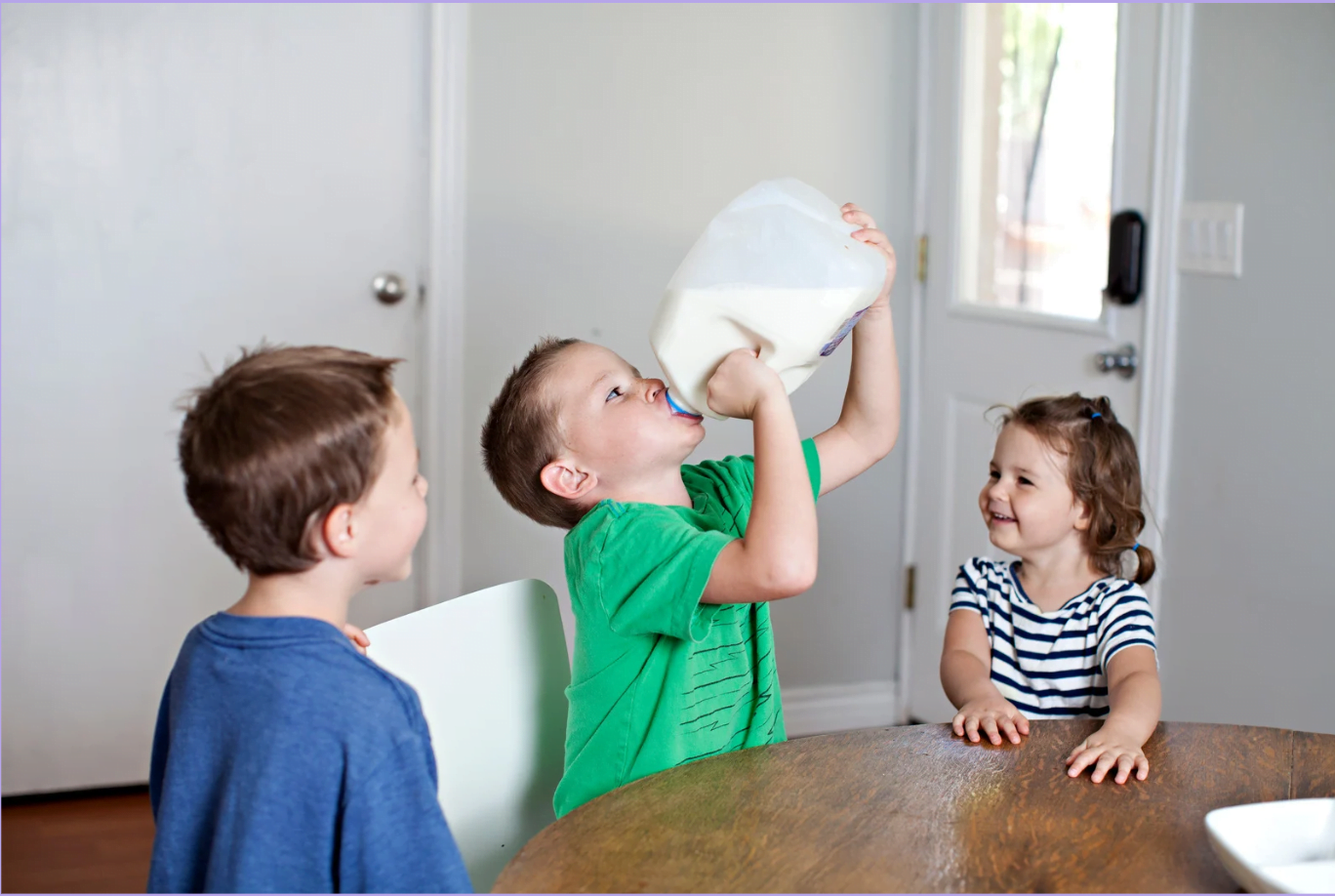How Much Milk Should Babies and Toddlers Drink?

If you’re questioning “how much cows milk for 1 year old,” rest assured, you’re not alone. Children at this age can typically have 2-3 cups (16-24 ounces) of cow’s milk per day.
In this article, we’ll break down the nutritional significance of this recommendation, help you understand the potential overconsumption risks, and guide you through the nuances of finding the right balance for your toddler’s diet.
How much cow's milk should babies under 1 drink?

The introduction of cow’s milk is a significant milestone in a toddler’s diet after they reach the age of one. This is because a child’s digestive system is now matured enough to handle the proteins found in cow’s milk, which is a stark contrast to their earlier inability to do so before they reached 12 months of age. However, serving cow’s milk as a primary drink before the age of one may result in nutritional deficiencies and digestive issues.
Introducing cow’s milk too early can lead to a host of health problems, including vitamin and iron deficiencies.
Also, early introduction might displace essential nutrients from human milk or formula, thus disrupting the child’s diet and impeding their growth and development.
Once your child reaches the age of one, child cow’s milk serves as a robust source of nutrients. Whole cow’s milk provides proteins for growth and muscle support, fats for brain development, and a range of vitamins and minerals such as vitamin D, calcium, and potassium. These nutrients are essential for your child’s growth and development.
What the right amount of milk for 1-year-olds?

Many parents wonder how much milk their 1-year-olds should consume daily. The recommended intake of cow’s milk for this age group is between 2-3 cups (16-24 ounces). This recommendation takes into account the total servings of dairy foods in a day, which includes not only liquid milk, but also yogurt and cheese. The overall dairy intake should generally amount to 1 2/3 to 2 cups per day according to the Dietary Guidelines for Americans.
However, you should be aware of the potential risks associated with excessive consumption of full fat cow’s milk. Consuming too much can lead to milk anemia and nutritional deficiencies, as it might diminish a toddler’s interest in consuming other nutrient-rich foods. If your toddler seeks more fluid than the recommended intake of cow’s milk, it’s advisable to offer water to satisfy their thirst and maintain a balance in their diet.
Factors Affecting Milk Intake
Determining the appropriate amount of cow’s milk for your child involves considering their individual needs, growth, and development. The selection of milk type and quantity should be based on the child’s growth and development, ensuring they receive sufficient nutrition for their developmental stage.
Considering these factors, the appropriate daily milk intake for a 1-year-old child is approximately 350-400mls or 16-24 ounces.
Transitioning from Breast Milk or Formula to Cow's Milk

Transitioning from breast milk or formula to cow’s milk is a pivotal step in your child’s dietary journey. The most effective approach is to introduce cow’s milk gradually by mixing it with breast milk or formula, adding it to meals, or offering small portions at a time. This method helps your child become familiar with the taste and texture of cow’s milk, making the transition smoother and more enjoyable for them.
The precise procedures for this transition involve:
Initiating the process by replacing one feeding with cow’s milk after the child reaches the age of one.
Progressively increasing the quantity of cow’s milk.
Gradually replacing bottles with cups of milk, making the process more suitable for your child’s development.
What's the best type of milk for a child?

The type of cow’s milk you offer to your toddler can significantly influence their nutritional intake. Whole cow’s milk is typically the most suitable option for most 1-year-olds due to its fat content, which is vital for babies’ growth. However, as your child grows older, you might want to consider introducing other types of milk.
Once your child reaches the age of two, you may begin transitioning to reduced-fat cow’s milk. The recommended approach for this transition is to offer reduced-fat (2 percent) milk for a few weeks in between whole milk and reduced-fat milk. For children with cow’s milk allergies or sensitivities, rice milk fortified with essential nutrients can be considered as an alternative.
If your child is overweight or has a family history of obesity, heart disease, and high blood pressure, it’s important to consult a pediatrician regarding the use of reduced-fat milk. Seeking professional advice can ensure the best dietary choices for your child’s health. Introducing cow’s milk in a sippy cup can help with the transition from a bottle and encourage independence in your child.
Pairing Milk with Solid Foods

Cow’s milk plays a significant role in a 1-year-old’s balanced diet by offering important nutrients like calcium and vitamin D, necessary for building strong bones. Also, it’s beneficial to pair cow’s milk with iron-rich and nutrient-dense solid foods to avoid nutrient deficiencies and encourage healthy growth.
Examples of such nutrient-dense foods include:
- beans and lentils
- chicken, turkey or beef
- fish like tuna or salmon
- tofu
- dark green leafy vegetables
- spinach muffins
- oatmeal
Fortified foods such as cereal, bread, oatmeal, and pasta provide beneficial nutrients and complement the nutritional profile of cow’s milk.
It’s worth noting that cow’s milk contains essential nutrients such as:
- Vitamins A and D
- Vitamin B12
- Calcium
- Riboflavin
- Phosphorus
- Potassium
All of these nutrients play a crucial role in promoting the healthy growth and development of toddlers.
What to do if my child is intolerant or allergic to milk?

Cow’s milk allergy, also referred to as cow’s milk protein allergy (CMA), involves an immune reaction to proteins in cow’s milk, constituting a genuine allergy. Conversely, cow’s milk sensitivity pertains to an intolerance to cow’s milk protein and is distinct from a true allergy.
Symptoms associated with cow’s milk allergy in 1-year-old children may encompass:
Wheezing
Difficulty breathing
Coughing
Hoarseness
Throat constriction
Gastrointestinal discomfort
Vomiting
Diarrhea
Bloating
Abdominal pain
Flatulence
Loose stools
Recognizing these symptoms early is important to provide appropriate care and manage your child’s diet effectively.
If your child is diagnosed with a cow’s milk allergy or sensitivity, it’s advisable to seek guidance from a pediatrician regarding the reintroduction of cow’s milk or alternative options. Always remember, your child’s health and well-being should be the priority when making dietary decisions.
What is the best dairy free milk alternative for kids?

For those children who cannot consume cow’s milk due to allergies or dietary restrictions, there are alternative options available. Fortified soy milk and oat milk are available as alternative milk options for children with allergies or dietary restrictions.
However, it’s important to carefully examine labels, verify that the alternatives are enriched with calcium and vitamin D, ensure they have adequate protein, and check that they are free from added sugar or sweeteners. The nutritional profile of the milk alternatives should match that of cow’s milk as closely as possible to ensure your child’s growth and development aren’t compromised.
Before incorporating any non-dairy milk alternatives into your child’s diet, it’s advisable to seek advice from a pediatrician to address potential nutritional deficiencies and to verify that any non-dairy milk alternatives fulfill the child’s dietary requirements.
Some non-dairy milk alternatives that are commonly used include:
Whole-fat soy milk, which is recommended for children under 2 years old to provide a similar fat content to whole cow’s milk
Almond milk
Rice milk
Oat milk
Coconut milk
Evaporated milk (non-dairy version)
It’s important to note that each non-dairy milk alternative has its own nutritional profile, so it’s important to choose one that meets your child’s specific needs.
How can I encourage my child to drink milk?

Promoting healthy milk consumption habits in children can help their growth and development. One way to promote these habits is to encourage them to drink milk, specifically drink cow’s milk, during mealtimes or as a component of their regular dietary intake. This can help them associate milk consumption with a regular eating schedule.
To enhance the appeal of cow’s milk for a child, you can serve cow’s milk gradually with new flavors by incorporating natural flavorings or blending the milk with fruits. This can help diversify your child’s palate and make the process of drinking milk more enjoyable.
In the event that a toddler has an aversion to milk, it is advisable to offer them calcium-rich foods to ensure adequate intake of this essential nutrient. This way, even if your child isn’t fond of milk, they can still receive the necessary nutrients for their development.
When do babies drop milk feeds?

Babies typically start dropping their milk feeds at different ages, and it can vary from one baby to another. There's no fixed schedule because each baby grows and develops at their own pace. However, here's a general idea of when it might happen.
Around 6 months many babies begin to show interest in solid foods. You'll start introducing them to things like mashed fruits and veggies. As they eat more solids, they might naturally reduce the number of milk feeds.
From 9-12 months babies are typically eating a variety of solid foods and might only need milk feeds in the morning and before bedtime. Some babies might drop daytime milk feeds altogether.
By12-24 months, as your baby gets older and eats more solid foods, they'll rely less on milk. By the time they're 2 years old, they might be drinking milk only a couple of times a day.
Take Homes
Cow’s milk should not be introduced to a child’s diet before the age of one due to the risk of nutritional deficiencies and digestive issues, but after reaching one year, it provides essential nutrients for growth and development.
The recommended intake of cow’s milk for 1-year-old children is 2-3 cups (16-24 ounces) per day, taking into account the total dairy consumption including yogurt and cheese, to avoid potential issues such as milk anemia.
Transition to cow’s milk should be gradual, mixing it with breast milk or formula initially, and whole milk is the preferred option for 1-year-olds unless allergies or other health considerations dictate a need for alternatives.

